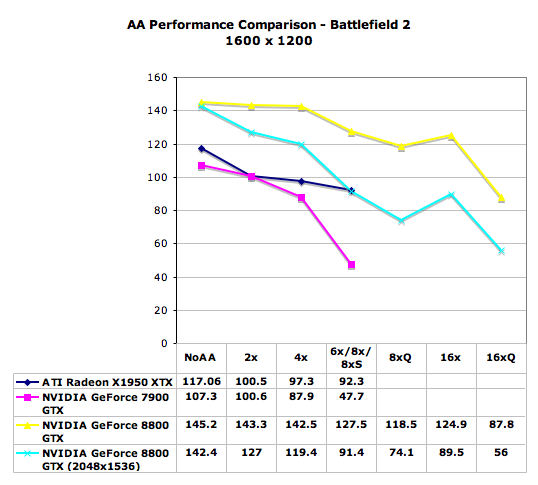NVIDIA's GeForce 8800 (G80): GPUs Re-architected for DirectX 10
by Anand Lal Shimpi & Derek Wilson on November 8, 2006 6:01 PM EST- Posted in
- GPUs
Our DX9FSAAViewer won't show us the exact sample patterns for CSAA, but we can take a look at where ATI and NVIDIA are getting their color sample points:
| ATI |  |
 |
 |
| G70 |  |
 |
 |
| G80 |  |
 |
 |
| G80* |  |
 |
 |
*Gamma AA disabled
As we can see, NVIDIA's 8x color sample AA modes use a much better pseudo random sample pattern rather than a combination of two rotated grid 4xAA patterns as in G70's 8xSAA.
While it is interesting to talk about the internal differences between MSAA and CSAA, the real test is pitting NVIDIA's new highest quality mode against ATI's highest quality.

G70 4X G80 16XQ ATI 6X
Hold mouse over links to see Image Quality

G70 4X G80 16XQ ATI 6X
Hold mouse over links to see Image Quality
Stacking up the best shows the power of NVIDIA's CSAA with 16 sample points and 8 color/z values looking much smoother than ATI's 6xAA. Compared to G70, both ATI and G80 look much better. Now let's take a look at the performance impact of CSAA. This graph may require a little explanation to understand, but it is quite interesting and worth looking at.

As we move from lower to higher quality AA modes, performance generally goes down. The exception is with G80's 16x mode. Its performance is only slightly lower than 8x. This is due to the fact that both modes use 4 color samples alongside more coverage samples. We can see the performance impact of having more coverage samples than color samples by looking at the performance drop from 4x to 8x on G80. There is another slight drop in performance when increasing the number of coverage samples from 8x to 16x, but it is almost nil. With the higher number of multisamples in 8xQ, algorithms that require z/stencil data per sub-pixel may look better, but 16x definitely does great job with the common edge case with much less performance impact. Enabling 16xQ shows us the performance impact of enabling more coverage samples with 8x multisamples.
It is conceivable that a CSAA mode using 32 sample points and 8 color points could be enabled to further improve coverage data at nearly the same performance impact of 16xQ (similar to the performance difference we see with 8x and 16x). Whatever the reason this wasn't done in G80, the potential is there for future revisions of the hardware to offer a 32x mode with the performance impact of 8x. Whether the quality improvement is there or not is another issue entirely.










111 Comments
View All Comments
JarredWalton - Wednesday, November 8, 2006 - link
The text is basically complete, and minor spelling issues aren't going to change the results. Obviously, proofing 29 pages of article content is going to take some time. We felt our readers would be a lot more interested in getting the content now rather than waiting even longer for me to proof everything. I know the vast majority of readers don't bother to comment on spelling and grammar issues, but my post was to avoid the comments section turning into a bunch of short posts complaining about errors that will be corrected shortly. :)Iger - Wednesday, November 8, 2006 - link
Pff, of course we would! If I would like to read a novel I would find a book! Results first - proofing later... if ever :) Thanks for the article!JarredWalton - Wednesday, November 8, 2006 - link
Did I say an hour? Okay, how about I just post here when I'm done reading/editing? :)JarredWalton - Wednesday, November 8, 2006 - link
Okay, I'm done proofing/editing. If you still see errors, feel free to complain. Like I said, though, try to keep them in this thread.--Jarred
LuxFestinus - Thursday, November 9, 2006 - link
Pg. 3 under <b>Unified Shaders</b>Should read as follows:
<i>Until now, building a GPU with unified shaders would not have <b>been</b> desirable, let alone practical, but Shader Model 4.0 lends itself well to this approach.</i>
Good try though.;)
shabby - Wednesday, November 8, 2006 - link
$600 for the gtx and $450 for the gts is pretty good seeing how much they crammed into the gpu, makes you wonder why the previous gen topped 650 bucks at times.dcalfine - Wednesday, November 8, 2006 - link
How does the 8800GTX compare to the 7950GX2? Not just in FPS, but also in performance/watt?dcalfine - Wednesday, November 8, 2006 - link
Ignore ^^^sorry
Hot card by the way!
neogodless - Wednesday, November 8, 2006 - link
I know you touched on this, but I assume that DirectX 10 is still not available for your testing platform, Windows XP Professional SP2, and additionally no games have been released for that platform. Is this correct? If so...Will DirectX 10 be made available for Windows XP?
Will you publish a new review once Vista, DirectX 10 and the new games are available?
Can we peak into the future at all now?
JarredWalton - Wednesday, November 8, 2006 - link
DX10 will be Vista only according to Microsoft. What that means according to some game developers is that DX10 support is going to be somewhat slow, and it's also going to be a major headache because for the next 3-4 years they will pretty much be required to have a DX9 rendering solution along with DX10.